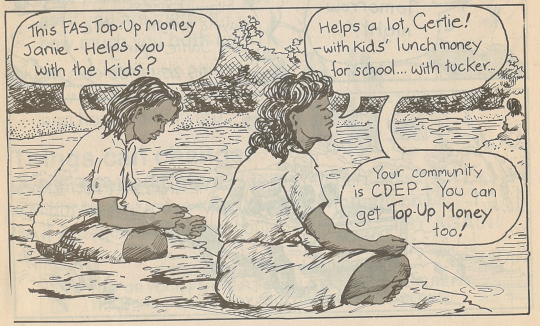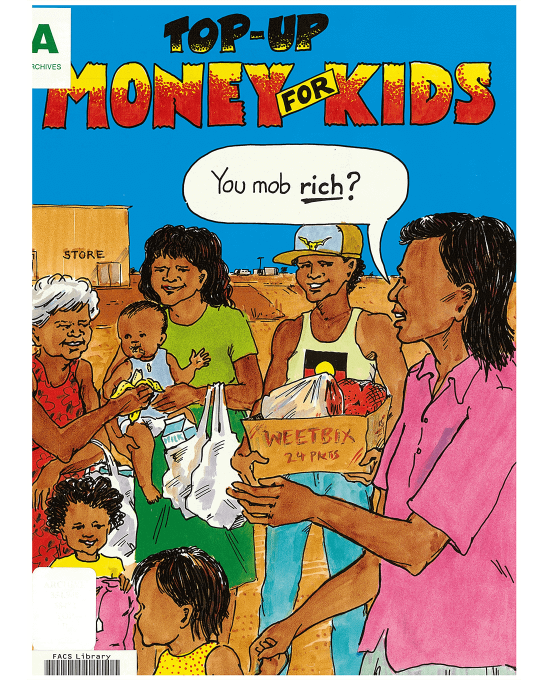
DSS uses comic to explain a new payment
To give Aboriginal and Torres Strait Islander families information about a new payment, DSS worked with Aboriginal professionals to publish a comic.
Hey! You mob rich?
Kids money came today - you get more with Top-up!
| Attachment | Size |
|---|---|
| top-up-money-for-kids.pdf | 22.45 MB |
| Attachment | Size |
|---|---|
| top-up-money-for-kids.docx | 87.59 KB |
To better engage Aboriginal families, the Department of Social Security (DSS) produced a comic about payments. They worked with Streetwize Comics, which was run through the Redfern Legal Service in Sydney. Aboriginal artists, writers and consultants led the design of the comic.
During the 1980s and 1990s, Streetwize produced free comics about social issues relevant to young people.
This issue, Top-up money for kids, explained Family Allowance Supplement (FAS). The appealing, colourful art style shows Aboriginal characters explaining the payment in short, sharp dialogue.
The new payment
In 1991, FAS was a fairly new payment. DSS had introduced it in 1987 to replace Family Income Supplement. FAS was a higher payment for low income working families with children who often weren’t getting another payment.
Because it was quite new and was for families who might not have interacted with DSS before, DSS was concerned people didn’t know they were eligible.
Using stories to explain the payment
To explain what the payment was, who could get it and how to apply, the comic used short illustrated stories. The stories were set in everyday situations, showing people at the football, fishing and buying food at the store.
Throughout the comics, the characters call FAS ‘top-up money for kids’.
In the first story, a mother, Janie, collects her FAS cheque at the post office and then uses it to buy food at the community store. Outside the store, friends see the family with lots of groceries. The friends ask, ‘You mob rich?’. Janie tells them ‘Kids money came today – you get more with top-up' and explains FAS.
Later, when fishing with family, Janie tells her friend Gertie how to apply for FAS.

The next story is set at a local footy match with new characters. Mary is visiting family and tells Aunty Helen that she has started a new job as a trainee health worker. Helen talks about FAS to Mary and goes with her to the DSS office to help fill out the application forms.
Some of the characters speak to each other in Pertame language, also known as Southern Arrernte. Pertame speakers are from Country south of Mpartnwe (Alice Springs), what is now part of the Northern Territory.

The comic ends by encouraging readers to talk with their Aboriginal Liaison Officer or Community Agent to find out if they could get FAS and other income support.
Main themes of the comic
The comic shows DSS trying to explain government payments in an appealing and relevant way. Trusted family networks guide the Aboriginal characters in the comics and they share information about payments to help each other. The comic used familiar settings and told positive stories about applying for and getting government payments.
Aboriginal writers and artists shaped the direction of the comic. This included Kathy Malera-Bandjalan, a Bundjalung woman from northern New South Wales. (Kathy was credited as Kathy Kum-Sing in the issue). Malera-Bandjalan was the lead Aboriginal consultant and writer on the project, and had worked with Streetwize Comics for over 10 years.
Frank McLeod, a self-taught Dunghutti artist from the north coast of New South Wales was an illustrator. McLeod had worked for Streetwize for years alongside Malera-Banjalan. Other collaborators on the comic include illustrators Prue Borthwick and Ross Carnsew, and writer Victoria Smith.
You can see more examples of Streetwize comics in the collections of the Museum of Applied Arts and Sciences online.
Permissions
Permissions to use this source were granted by Frank McLeod and by Kathy Malera-Bandjalan’s daughter Kyra Kum-Sing.
Permissions were also granted by Denise North on behalf of Streetwize Communications, Rob Oerlemans, formerly Streetwize Project Committee, and Prue Borthwick.
Consultation with Elders who are Pertame language speakers was facilitated by Vanessa Farrelly, to confirm the language used was appropriate to include here. The original translator was not identified.
Citation
Streetwize Comics (1991) Top-up money for kids [comic], Streetwize Comics and Department of Social Security, Australia.
